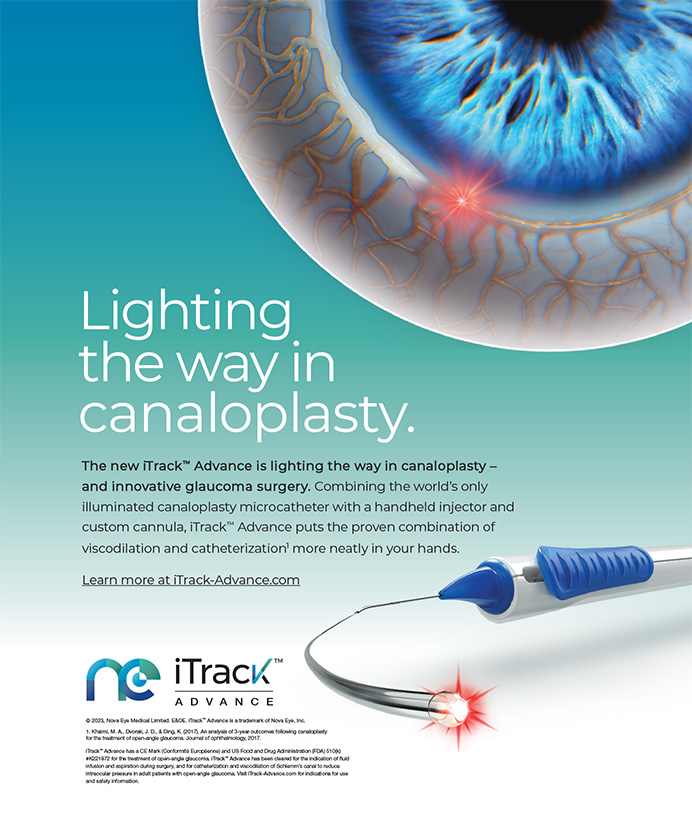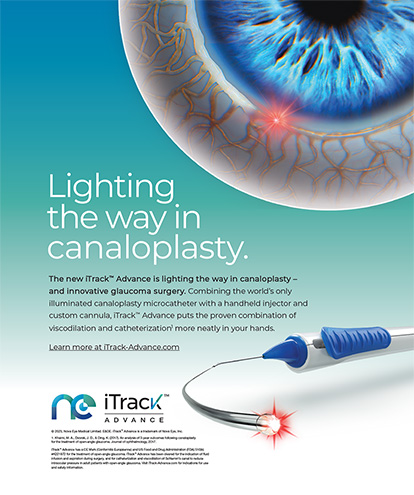Cataract and glaucoma frequently occur in the same patient, especially as the world’s population ages. Studies have shown that cataract surgery alone is capable of modestly reducing IOP and minimizing the patient’s need for multiple eye drops to control his or her IOP.1 The decrease may be larger when the baseline pressure is higher. Many theories have been proposed to explain this effect in terms of anatomical and biochemical changes after cataract surgery. Questions remain as to the longevity of the reduction in IOP, its effect on diurnal pressure control, and how low the IOP can get.
The ideal candidate for cataract surgery alone has a visually significant cataract, mild glaucoma, and an IOP that is controlled by less than maximally tolerated medical therapy. Surgeons usually decide to perform cataract surgery combined with a filtering procedure when patients have moderate or advanced glaucoma and/or uncontrolled IOP, but significantly greater risks of complications are to be expected. They include shallow chambers, hypotony, choroidal effusion, malignant glaucoma, bleb leaks, and infection.2 This article discusses a new option that may soon fit into this continuum: the iStent (Glaukos Corp., Laguna Hills, CA) combined with cataract surgery.
ABOUT THE DEVICE
On July 30, the FDA’s Ophthalmic Devices Panel of the Medical Devices Advisory Committee voted in favor of a premarket approval application for the iStent. This L-shaped, half-pipe lumen design is 1 mm in length and is made of heparin-coated titanium (Figure 1). The device is implanted through a clear corneal or scleral incision (minimum 1.5 mm wide) via an ab interno approach that bypasses the trabecular meshwork and re-establishes continuous physiological outflow through the canal of Schlemm. According to the manufacturer’s Web site, the iStent is the smallest medical device ever to be implanted in the human body.3 In studies of its effect on human anterior segments in perfused cultures, the IOP decreased significantly after the insertion of one iStent. The effect of implanting multiple devices has also been studied.4
RESULTS TO DATE
Since the iStent’s approval in Canada and Europe, clinicians have performed a number of studies investigating the new device. A prospective, nonrandomized, uncontrolled, multicenter study in Germany, Spain, and Switzerland by Spiegel et al5 enrolled patients with uncontrolled primary open-angle glaucoma (subjects had pigmentary glaucoma and pseudoexfoliation). Patients underwent clear corneal phacoemulsification followed by the ab interno implantation of the iStent. The IOP reduction from baseline achieved by the iStent group ranged from 3.4 to 5.9 mm Hg, and the decrease in glaucoma medications after 12 months ranged from 1 to 1.3 per patient.
In Italy, Fea studied the effect of combining the iStent’s implantation with cataract surgery.6 This prospective, randomized, double-masked study enrolled patients with primary open-angle glaucoma who were taking multiple pressure-lowering medications and had a visually significant cataract. Fea compared phacoemulsification alone (control group) and phacoemulsification with the implantation of the iStent. Fifteen months postoperatively, the mean IOP in the combined group was 14.8 ±1.2 mm Hg (from a baseline of 17.9 ±2.9 mm Hg), which was statistically significantly lower than the IOP in the control group (15.7 ±1.1 mm Hg, from a baseline of 17.3 ±3 mm Hg). Moreover, after a washout of ocular hypotensive agents for 1 month (16 months after surgery), the mean IOP in the combined group was 16.6 ±3.1 mm Hg, which was statistically significantly lower than the mean IOP of 19.2 ±3.5 mm Hg in the control group. Fea found that, after surgery, both groups used fewer medications, but after 15 months, 24% of patients in the control group were free of drops compared with 67% in the combined group. Another study has supported the longevity of the effect of the stent and reported a mean IOP reduction from the medicated baseline of 5.1 ±4.2 mm Hg at 24 months.7
Our Canadian study supports previous results. Furthermore, in 61 patients (30 with two stents and 31 with three stents), we have found that implanting more than one iStent (typically, 2 clock hours apart, ideally in an area of significant collector channels noted by a reflux of blood in Schlemm’s canal) further reduces the IOP (mean IOP was 13.9 mm Hg with two devices and 14.1 mm Hg with three devices 12 months after surgery). Moreover, the implantation of three stents combined with phacoemulsification showed stricter control over IOP-lowering medications postoperatively: 93% of patients were free of drops 12 months after surgery.8
All of the investigators mentioned agree about the iStent’s safety.6-8 In these studies, there were no adverse effects or recorded cases of hypotony, a shallow chamber, or a choroidal effusion—complications commonly encountered when conventional glaucoma procedures are combined with cataract surgery. We have not found migration or movement of the device to be a problem, but some patients with narrow angles and a plateau iris configuration are at risk for the development of peripheral anterior synechiae to the device. Fortunately, this complication is rare and can be successfully treated with a laser. Nevertheless, we currently recommend caution when implanting the iStent in eyes with narrow angles and a plateau iris configuration.7
SUITABLE CANDIDATES
The iStent is indicated for use in conjunction with cataract surgery for the reduction of IOP in patients with mild-to-moderate open-angle glaucoma. We usually define mild-to-moderate open-angle glaucoma as a visual field score with a mean deviation of better than -12 dB, but this should be tailored to the individual patient. Regarding IOP-related indications, the pressure may be controlled, but the physician and patient may desire to reduce the number of or eliminate medications. Alternatively, the IOP may be borderline or uncontrolled on the current medical regimen, so the goal is to lower the IOP and possibly reduce the patient’s use of medication.
Patients with pseudoexfoliation and pigmentary dispersion syndrome have reportedly achieved good results with the iStent. Gonioscopy is very important in this population to avoid implanting the device in eyes with narrow angles (Shaffer grade 2 or less).
Patients with advanced glaucoma and uncontrolled IOP are not appropriate candidates for the iStent. Surgeons should consider more aggressive procedures.
ADVICE ON IMPLANTATION
The iStent’s implantation requires some technical abilities, but the average cataract surgeon who is familiar with gonioscopy and identifying angle structures should face a relatively modest learning curve. For the first few implantations, we suggest choosing a patient whose eye has some trabecular pigmentation to assist with the identification of landmarks.
The iStent comes preloaded in a single-use sterile inserter and is implanted at the end of the cataract case through the same corneal incision. A gonioprism and slight tilting of the microscope and the patient’s head permit visualization. With the help of an ophthalmic viscosurgical device in the anterior chamber, the stent can be inserted upon identification of the trabecular meshwork—akin to inserting an IV line (Figure 2). Surgical trauma is minimal.
In the Canadian study of the device, investigators who had not previously implanted the iStent were able to do so successfully on their first attempts. The orientation of the microscope was usually the main challenge, but virtually all surgeons mastered the technique by the second implantation.
CONCLUSION
In our experience, combining cataract surgery with the iStent’s implantation resulted in bettercontrolled IOP on fewer or no medications postoperatively. Patients are comfortable, and they have a quick recovery. Because of the reduction in medications, they typically have fewer problems with the ocular surface. It is important to emphasize that the iStent’s implantation does not negatively affect the patient’s candidacy for more aggressive glaucoma surgery if required. Aside from rare events, the worst scenario is that the device will have minimal efficacy. In that case, the patient should still benefit from the cataract procedure and can undergo further glaucoma surgery if need be.
Mahmoud Rateb, MD, is a clinical research fellow in the Department of Ophthalmology at the University of Toronto. He acknowledged no financial interest in the products or companies mentioned herein. Dr. Rateb may be reached at rateb.cvec@gmail.com.
Iqbal Ike K. Ahmed, MD, FRCSC, is an assistant professor of ophthalmology in the Department of Ophthalmology at the University of Toronto. He is a consultant to Clarity Medical Systems, Inc., and Glaukos Corp. Dr. Ahmed may be reached at (905) 820-3937; ike.ahmed@utoronto.ca.
- Vizzeri G,Weinreb RN.Cataract surgery and glaucoma.Curr Opin Ophthalmol. 2010;21:20-24.
- Friedman DS,Jampel HD,Lumboski LH,et al.Surgical strategies for coexisting glaucoma and cataract:an evidence-based update.Ophthalmology. 2002;109:1902-1913.
- Nichamin LD.Glaukos iStent trabecular micro-bypass.Middle East Afr J Ophthalmol.2009;16(3):138-140.
- Bahler CK,Smedley GT,Zhou J,Johnson DH.Trabecular bypass stents decrease intraocular pressure in cultured human anterior segments.Am J Ophthalmol. 2004;138:988-994.
- Spiegel D,Wetzel W,Neuhann N,et al.Coexistent primary open-angle glaucoma and cataract:interim analysis of a trabecular micro-bypass stent and concurrent cataract surgery.Eur J Ophthalmol.2009;19:393-399.
- Fea AM.Phacoemulsification versus phacoemulsification with micro-bypass stent implantation in primary open-angle glaucoma.Randomized doublemasked clinical trial.J Cataract Refract Surg.2010;36:407-412.
- Craven R,Samuelson T,and the GC002 Study Group.Poster presented at:The American Glaucoma Society Annual Meeting;March 5-8,2009;San Diego,CA.
- Belovay GW,Ahmed II.Using multiple trabecular micro-bypass stents in cataract patients to treat primary open-angle glaucoma.Presented at:The ASCRS Symposium on Cataract,IOL and Refractive Surgery;April 9-14,2010;Boston,MA


